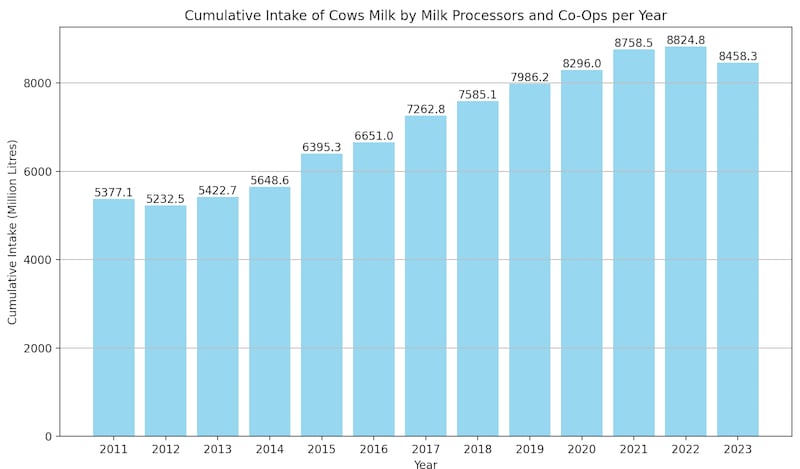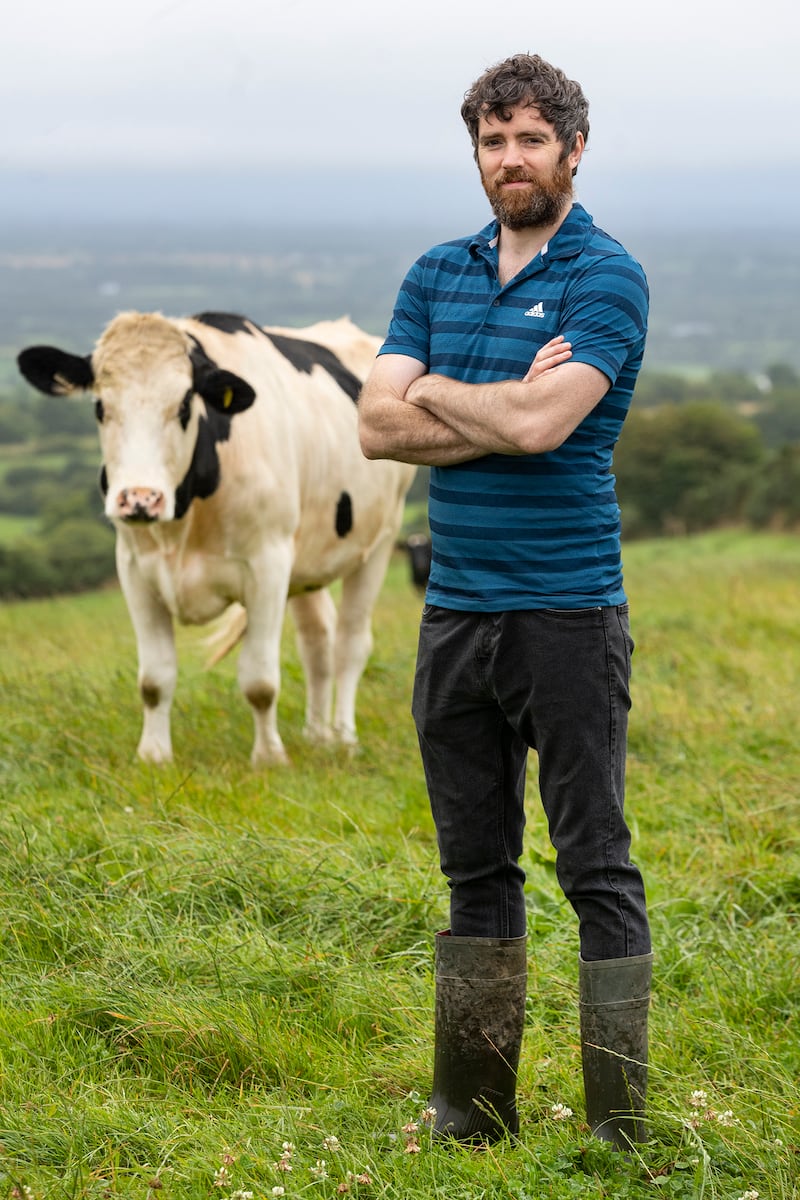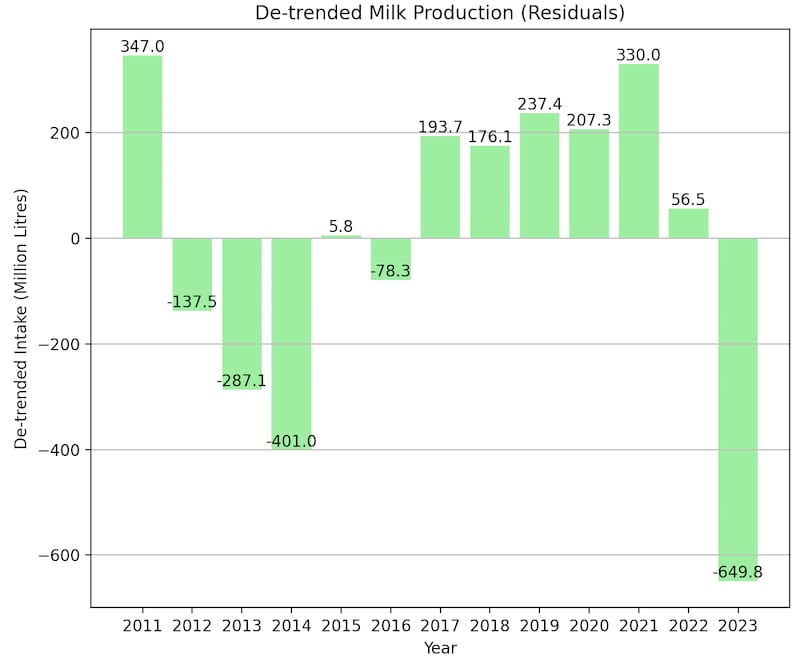“The idea of global warming is often met happily in Ireland with a ‘great, now we can grow our own grapes and go to the beach’,” says Mark Kelly, who is a rare breed as a data scientist and farmer.
The rainfall patterns experienced for almost a year in Ireland, exacerbated by climate change, suggest we should be a lot more concerned, he says. Kelly believes such trivial reactions are down to the fact “global warming” – aka climate change – “is far too benign a term”.
He prefers the term “global weirding”. It is regularly used by New York Times opinion writer Thomas Friedman and increasingly by some eminent climate scientists.
“This is exactly as it sounds – the defining characteristic difference between pre-industrial weather and now is its weirdness.”
It aptly sums up the crazy impact of global warming, Kelly adds. “Places will get hotter and colder, dryer and wetter. Storms will visit places they never had before. If this term had been adopted from the outset we wouldn’t have had to deal with 99 per cent of climate change denialism: ‘it’s raining and cold outside so the scientists must be having us on’.”
After almost unrelenting rain since the middle of last year, Kelly decided to investigate if his hunch was correct; that it was out of the ordinary and that there was evidence of “global weirding” occurring here, with the possibility that Irish weather patterns may be changing irrevocably.
A drystock farmer from Borrisoleigh, Co Tipperary, Kelly says his findings indicate Irish food production may be entering a period of prolonged uncertainty. His findings suggest the traditional breadbasket of the country, tillage areas in the east, are especially vulnerable.
He picked a couple of weather stations in Co Roscommon with good historical records – Loughglinn and Mount Dillion – and plotted the cumulative rainfall from June 1st to May 31st of the following year from 1944 through to this year.
In a series of graphics presented last May on his blog, the Carbon Pulse, he showed the stations have in recent months had their third-wettest period since 1944. Tellingly, the two wetter periods were 2015-2016 and 2020-2021. He produced a data visualisation showing how this has worsened since 1944, highlighting the more dramatic changes of recent years.
Kelly likes to picture the weather as following an average trajectory (“the mean”), and the departures from the norm fall within a certain distance from the mean (“the standard deviation”). Critically, the wettest period was almost 50 per cent wetter than the mean.
“Global weirding means those departures from the norm are much wilder than they were in pre-industrial times,” he says.
And nothing has happened since May to change his view.
[ Irish farmers see income drop sharply in 2023, notes Teagasc surveyOpens in new window ]
What all of this means for Ireland, Kelly says, is that “long before the apocalyptic sea-level rise, food production will be impacted since all our crops evolved during 10,000 years of steady, fairly predictable weather”.
His blog focuses primarily on energy security and food security and his analysis of Ireland’s food production, ie crop yields from 2008 to last year, shows three dips in the past six years. Milk yields are “an instant signal, since more rain means less grass for cows, and less milk”.

A superficial look at figures “looks pretty good with a steady increase, and only a slight dip in 2023″, he wrote. “So much for global weirding, eh? Well not quite. Much of this increase is explained by farmers switching over to dairy from other enterprises over recent years. Here’s the increase in Ireland’s national dairy herd. So the dip in milk production in 2023 may be a stronger indicator than it first appears.”
He compared Central Statistics Office data for the first three months of this year to other years. “So 2024 milk production is indeed reflecting the terrible levels of global weirding – in our case all that rain – we’ve had over the past 11 months.”
Data from Teagasc and the Environmental Protection Agency confirms dairy cow numbers increased by 0.6 per cent last year, however total milk production decreased by 4.7 per cent – due to lower grass yields, with heavy rainfall being the major factor.
[ Potato shortages: ‘The way the weather is going, it’s a bit frightening’Opens in new window ]
Kelly, a part-time farmer raising 100 beef cattle, is concerned by the lack of preparedness for the consequences of global weirding, Irish-style.
“It is often stated that Ireland is the most food secure country in the world. This is nonsense,” he says. “If you ignore essential food groups and just count up all the calories we produce from dairy, and look at all the calories we eat, you could say we’re food secure. Nobody can live on milk and butter alone though. In reality, Ireland currently imports four calories of every five that it eats, two-thirds of the protein eaten and three-quarters of the essential fats.”

Given global weirding evidence beyond Ireland, he warns that “at some point you won’t have that option”.
“Global weirding means every country is going to have their own version… With countries experiencing hits to their food production, how willing will they be to export? And where does that leave Ireland?”
Nothing could be more important than food security, he says, but the Irish model is still completely reliant on the old economic principle of comparative advantage – “the idea that if country A produces nuts and apples, but is better at nuts, and so does country B, but it’s better at apples, then country A should concentrate on nuts and country B on apples, bringing the cost down for all market participants. Comparative advantage doesn’t apply when country B can’t produce enough nuts because it’s been hit by flooding.”
‘Long before the apocalyptic sea-level rise, food production will be impacted since all our crops evolved during 10,000 years of steady, fairly predictable weather’
His 81-year-old father phoned him some months ago to tell him “you were right all along” – a view he is increasingly getting from other farmers as “the penny has dropped”. His neighbours are experiencing considerable fodder shortages with a dual problem of lack of grass and being unable to get cattle out on grass on time. Because his farm is less intensive, Kelly says he is lucky to have enough silage, which others buy from him.
Ireland’s lack of preparedness worries him; manifested by a business-as-usual mindset. We continue to be almost totally reliant on imported fossil fuels to produce food; there is a lack of variability in agri-food production while there is a view that intensive dairying and beef production (83 per cent of the sector) “will keeping coming”. Yet, he points to those struggling in the vegetable sector “who have had their strangest year ever”.
Kelly says focusing on carbon emissions is not helpful. “[It] just leads to trickery – like outsourcing our manufacturing – and therefore emissions – to China, while increasing our consumption, and saying we have reduced emissions. Stuff like that is just not helpful in any way.”

He adds: “I don’t for a second think that Irish farmers reducing emissions will make the slightest difference to climate change. That’s why I don’t focus on emissions. The only thing that would make a difference is if billions of people voluntarily reduced consumption. That is very very unlikely. I believe every molecule of oil, gas and coal that can be burned profitably somewhere, will be.”
Having recently completed a postgraduate degree in renewable energy at Dundalk IT, Kelly is planning a blog series analysing issues in the sector.
While he accepts his rainfall analysis amounts to early indications of future trends, he adds: “We’ll know more in three to four years. They do point to the beginning of food security issues inevitably brought on by global weirding. Ireland urgently needs to take food security seriously and start incentivising the production of food locally across all food groups.”
But he has already reached the emphatic conclusion that “current production is not sustainable for all the reasons I have highlighted”.
